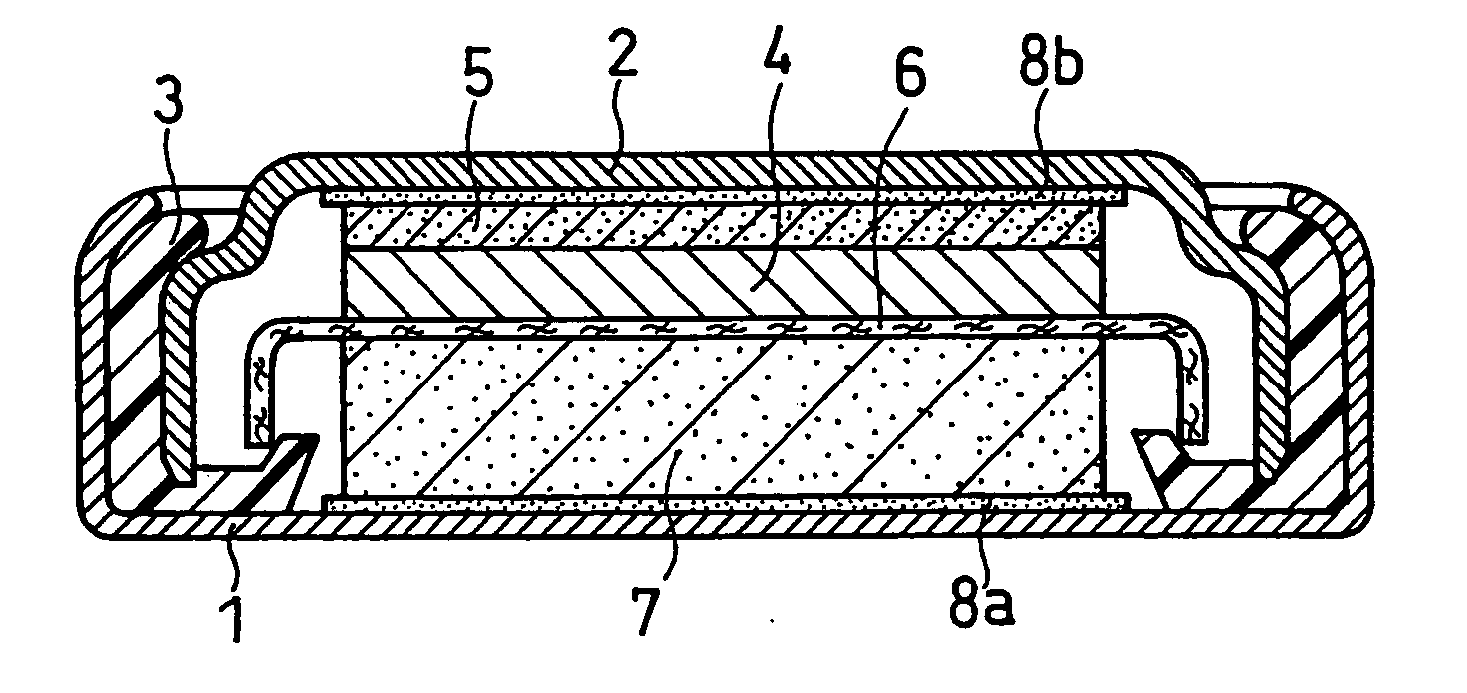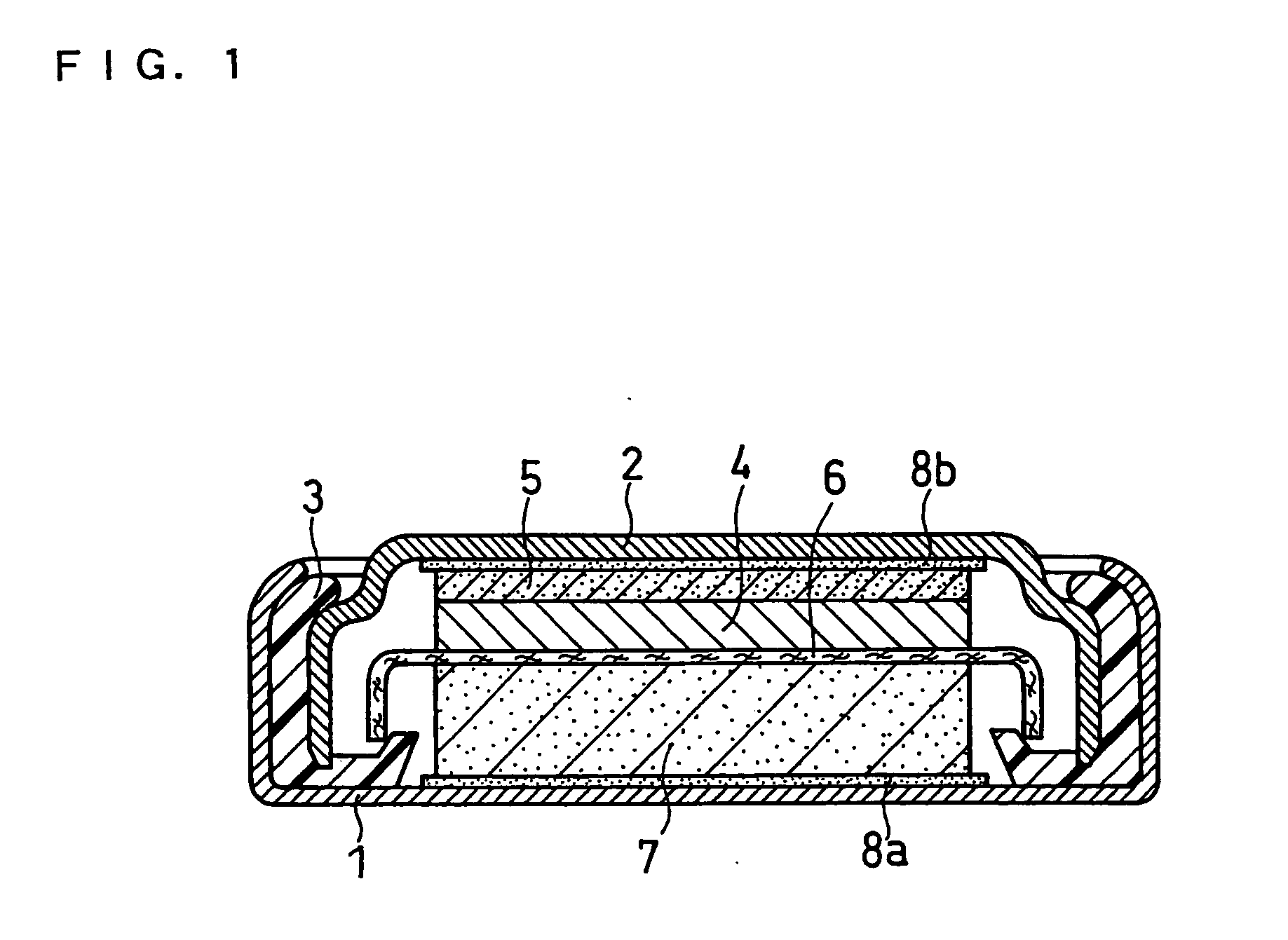Non-aqueous electrolyte secondary battery
a secondary battery, non-aqueous electrolyte technology, applied in the direction of cell components, final product manufacturing, sustainable manufacturing/processing, etc., can solve the problems of increasing the contact resistance among particles in the negative electrode, degrading the current collecting network, and significant problems to be solved, etc., to achieve excellent charge/discharge cycle characteristics, excellent cycling characteristics, and high capacity
- Summary
- Abstract
- Description
- Claims
- Application Information
AI Technical Summary
Benefits of technology
Problems solved by technology
Method used
Image
Examples
example 1
[0087] In Examples and Comparative Examples, negative electrodes and coin-shaped batteries were produced in the following manner, and their cycle life and discharge capacity were evaluated.
(1) Alloying Material Preparation
[0088] Ti, Zr, Ni, Cu, and Fe were used in metallic form as raw materials for the transition metal element M. Each metal was in powder form having a purity of 99.9% and a particle size of 100 to 150 μm. Also, a Si powder having a purity of 99.9% and a mean particle size of 3 μm was used as the raw material for Si.
[0089] These raw materials were mixed together in the following weight ratios such that the weight of the A phase relative to the total weight of the A phase and the B phase in the resultant alloying material would amount to approximately 80% on the assumption that MSi2 would form as the B phase.
[0090] Ti:Si=9.2:90.8
[0091] Zr:Si=12.4:87.6
[0092] Ni:Si=10.2:89.8
[0093] Cu:Si=10.6:89.4
[0094] Fe:Si=10.2:89.8
[0095] Each powder mixture of 3.5 kg was pla...
example 2
[0123] In this example, the crystallite size of alloying materials was examined in detail.
[0124] The crystallite size of alloying materials was varied as shown in Table 3 below by changing the conditions of the mechanical alloying operation (frequency and operation time). In the same manner as in Example 1 except for the variations in crystallite size, various alloying materials were produced such that the weight ratio between the A phase and B phase would be 80:20. These alloying materials were then classified, to obtain a Ti-Si alloying material, a Zr—Si alloying material, a Ni—Si alloying material, a Cu—Si alloying material and an Fe—Si alloying material, each having a maximum particle size of 8 μm and a mean particle size of 5 μm.
[0125] In the same manner as in Example 1, the crystallite size of the A phase was calculated from the half width of the most intense peak obtained by X-ray diffraction analysis of each alloying material and the Scherrer equation.
[0126] In Table 3, a...
example 3
[0135] In this Example, in a diffraction spectrum obtained by performing an X-ray diffraction analysis of an alloying material with CuKα rays as the radiation source, the half width of the most intense diffraction peak in the range of diffraction angle 2θ=10° to 80° was examined in detail.
[0136] The half width of the most intense diffraction peak was varied as shown in Table 4 below by changing the conditions of the mechanical alloying operation (frequency and operation time). In the same manner as in Example 1, except for the variations in half width, various alloying materials were produced such that the weight ratio between the A phase and B phase would become 80:20. These materials were then classified, to obtain a Ti—Si alloying material, a Zr—Si alloying material, a Ni—Si alloying material, a Cu—Si alloying material and an Fe—Si alloying material, each having a maximum particle size of 8 μm and a mean particle size of 5 μm.
[0137] In Table 4, although the half width of only t...
PUM
| Property | Measurement | Unit |
|---|---|---|
| Length | aaaaa | aaaaa |
| Fraction | aaaaa | aaaaa |
| Fraction | aaaaa | aaaaa |
Abstract
Description
Claims
Application Information
 Login to View More
Login to View More - R&D
- Intellectual Property
- Life Sciences
- Materials
- Tech Scout
- Unparalleled Data Quality
- Higher Quality Content
- 60% Fewer Hallucinations
Browse by: Latest US Patents, China's latest patents, Technical Efficacy Thesaurus, Application Domain, Technology Topic, Popular Technical Reports.
© 2025 PatSnap. All rights reserved.Legal|Privacy policy|Modern Slavery Act Transparency Statement|Sitemap|About US| Contact US: help@patsnap.com


